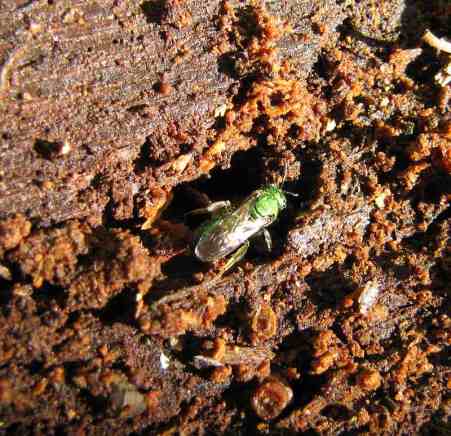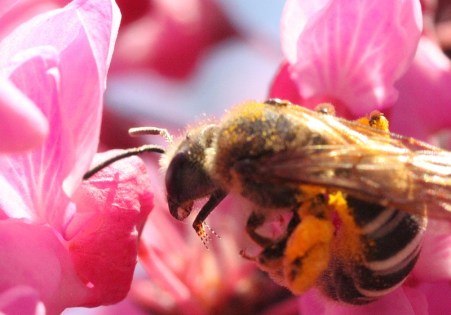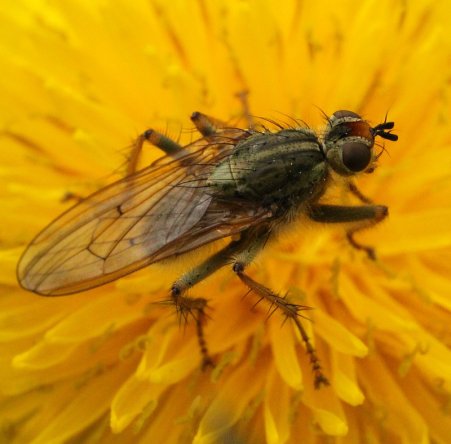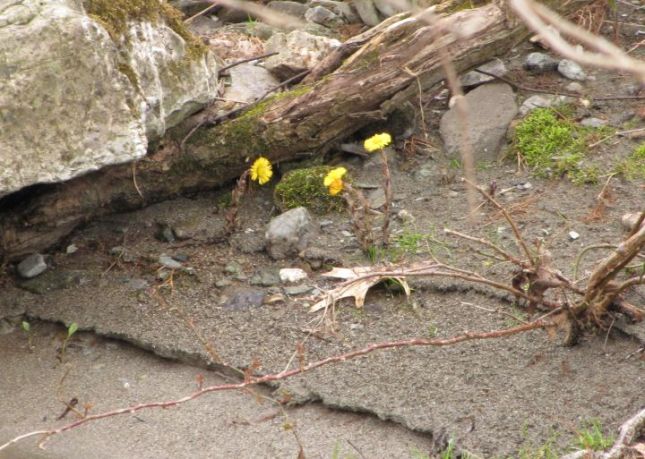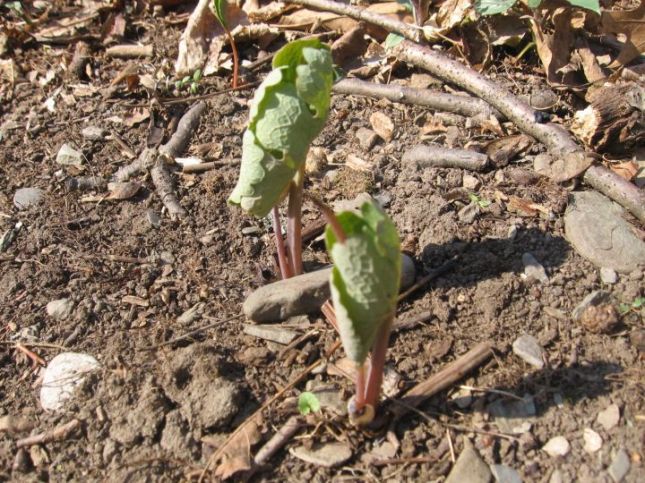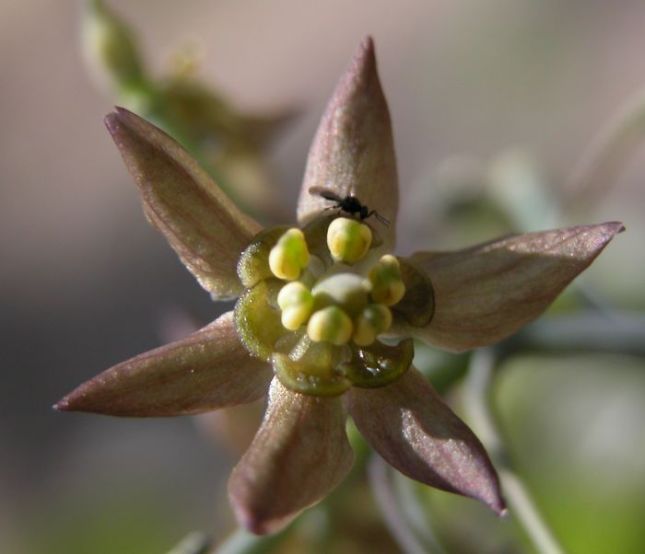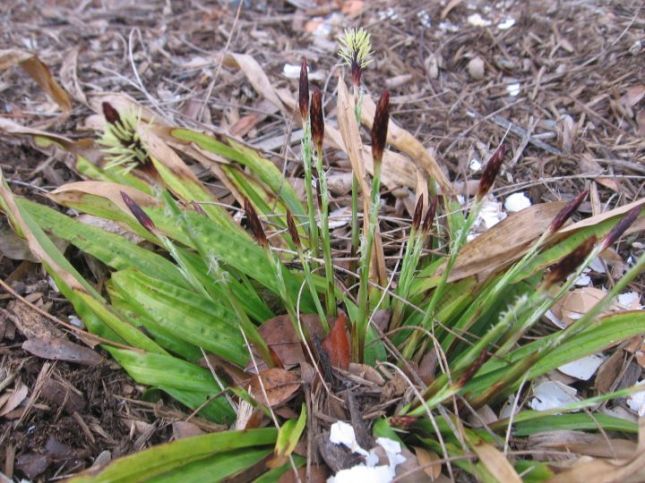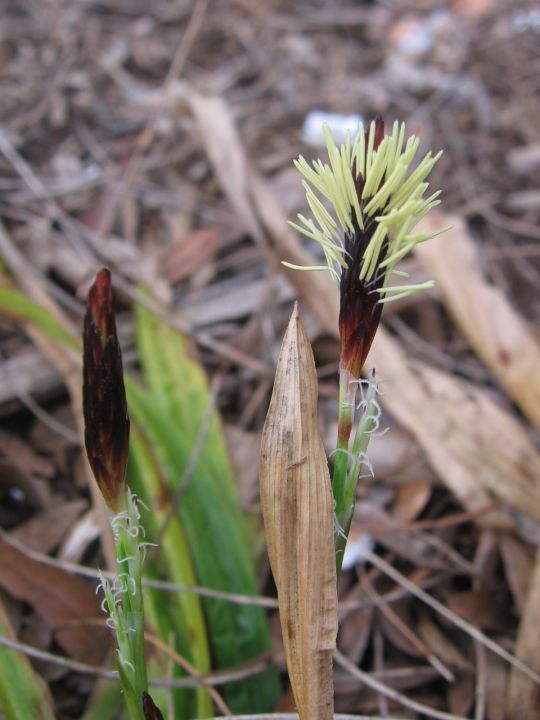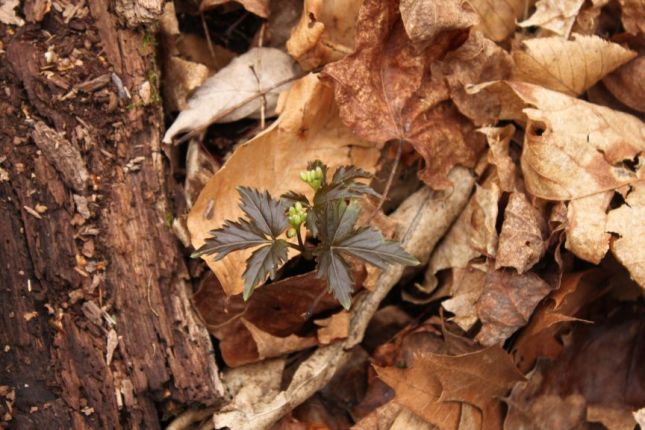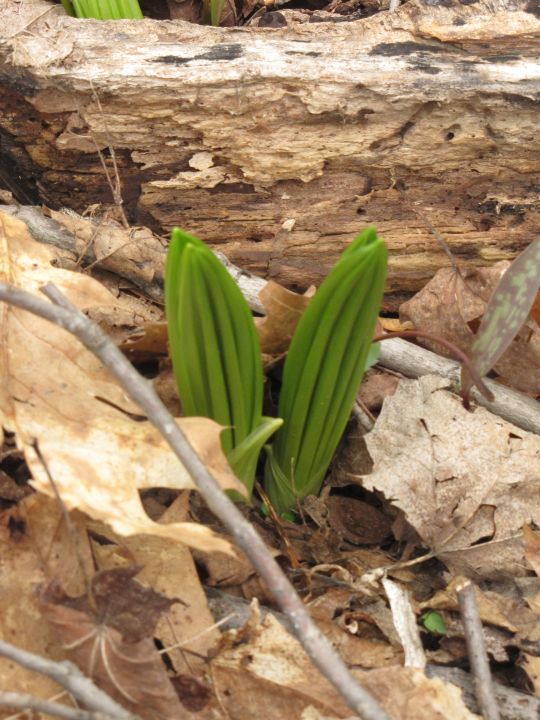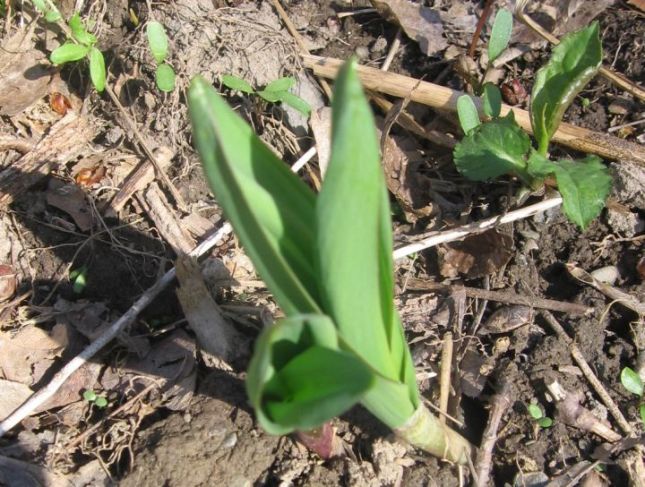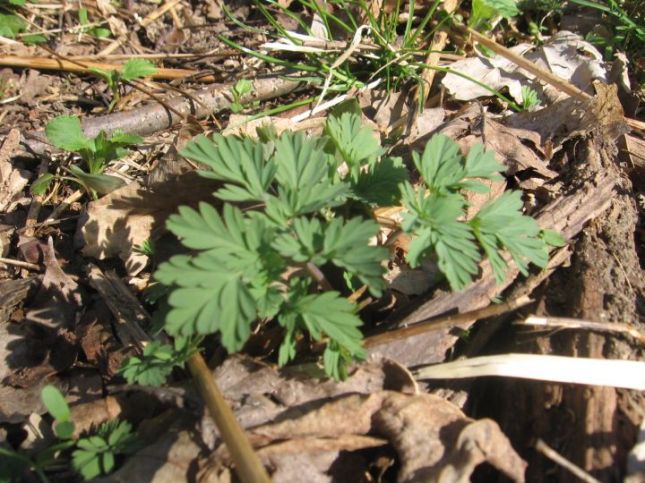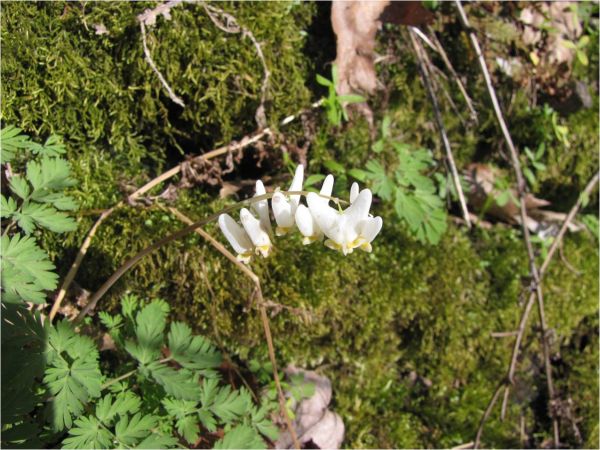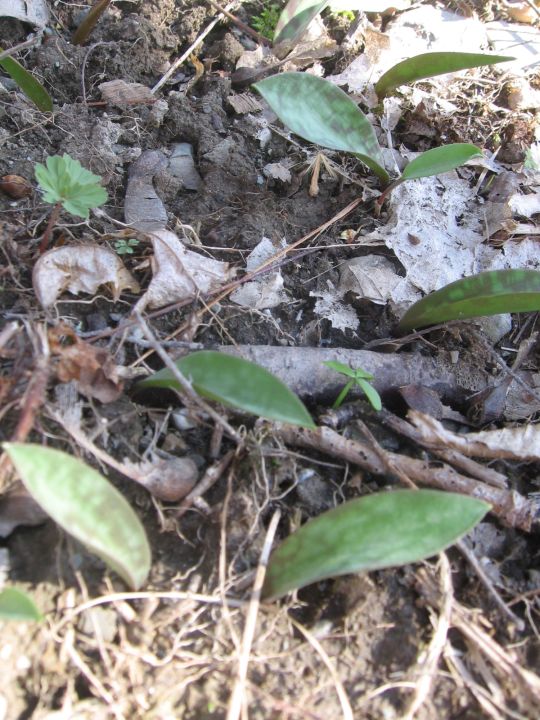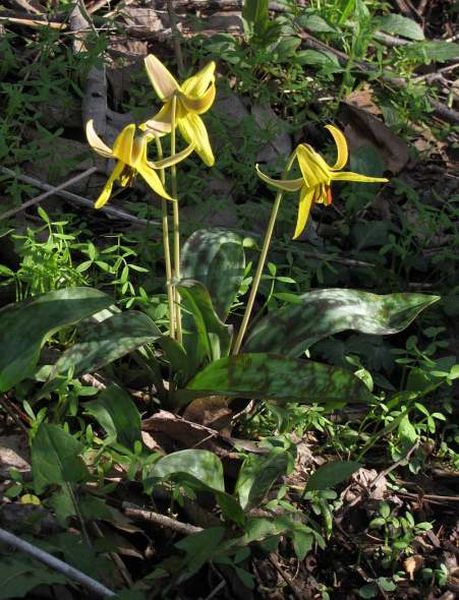As Spring arrives, so do the flowers and the bees. Honey Bees, our most familiar bee, sally forth from their hives; gathering pollen and nectar for their young and their colony and, almost incidentally, pollinating many of the flowers they visit. Most ‘bee keepers’ in this part of the World are keepers of Honey Bees. This is understandable given the honey this species produces. However, we are all ‘bee keepers’ of another sort. Aside from the European Honey Bee, which probably arrived here in the 1600s, there are around 475 species of native bees in New York State, and we’ve documented at least 120 from Columbia County. These species survive (or not) in the house that we all keep: our countryside. Not all of our local bees are currently flying – some bees only emerge later in the season, however, there is already a nice variety out and about.
[First a word of warning and gratitude: I am hardly a native bee expert. I’ve gotten some friendly input from the folks at Bugguide (John Ascher of AMNH specifically) and have made some risky guesses on others. Martin Holdrege and now Sara Powell have been working through IDs with us; in part, I’ll try to summarize some of their work. For more on Martin’s work looking at the native bees in the County, see this page of our web site.]
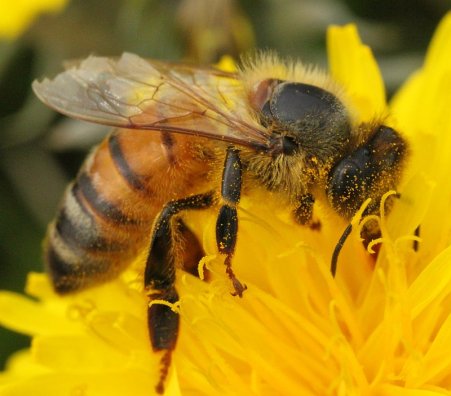
Before delving further into our native bees, we should take at least one good look at the imported, but now naturalized, Honey Bee. Honey Bees are larger than many (but certainly not all) of our native bees. One characteristic that distinguishes them from almost all of our native bees is, however, their hairy eyes. Notice how the Dandelion pollen has gotten stuck in the hairs which extend between the cells of this Honey Bee’s eyes; one can only imagine what the view from the inside was like.
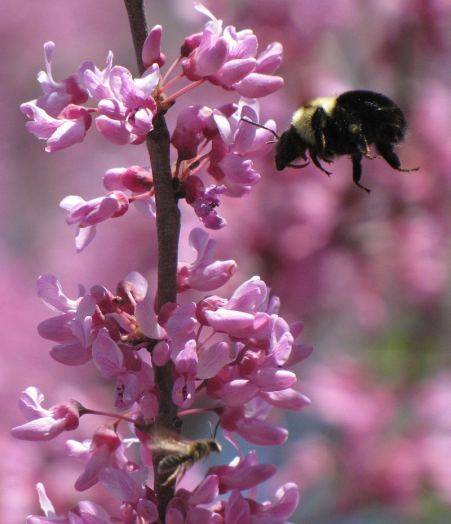
Bumblebees are perhaps our most familiar native bees. This one (possibly Bombus impatiens, the Common Eastern Bumblebee) is sharing this Redbud branch with a smaller native bee that is flying past below. Our smallest native bees are about 1/4-1/2 the length of the lower bee. Stake out a flowering tree or patch and watch it for a while. Many (but not all) of the fly-sized insects you’ll see zooming about are actually those smaller native bees.
We have around 14 species of Bumblebees in the State. Many of these nest underground (in such places as old groundhog or mouse burrows); others nest on the ground surface or in cavities in wood, rocks or structures. Each year, the fertilized queen raises a new colony. The old queen and all offspring, except next year’s prospective queens, will die by the end of the season; only those young queens survive the winter and found a new colony the following spring. Bumblebees are especially important pollinators at cooler times of the year; as this BBC video illustrates, they can use their unhitched flight muscles to generate the body heat that they need in order to fly. Their relatively large size and fuzzy coat presumably help maintain that heat.
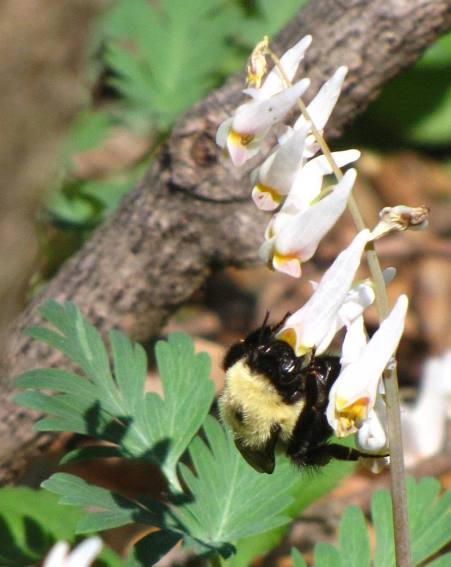
The ability to cope with cool weather means that Bumblebees can be the pollinators of many of our early spring flowers, such as this Dutchman’s Britches. The spring ephemeral flowers of our rich bottomlands can provide important food resources for early Spring bees.
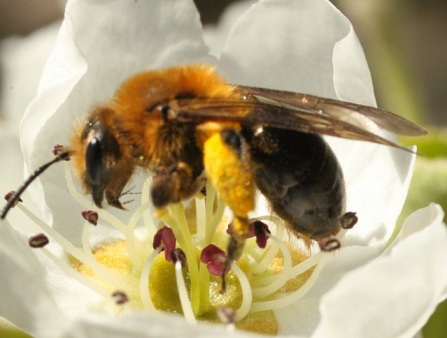
Here’s another fuzzy native bee, but this is not a Bumblebee. Slightly smaller than most of our Bumblebees and somewhat redder, this may be, according to John Ascher, Andrena dunningi. Note the mouth parts; many bees have an extendable mouth with which they can probe flowers. The mouth of this bee is apparently retracted, more on bee mouths later.
Andrena dunningi is an example of one group of Spring bees. You will only find this species in flight during early spring (perhaps April – May in our area). These are gregarious but solitary ground nesters. What that means is that each female makes her own hole in a sand/clay bank. However, either because of an urge to hang out together or because of similar nesting site preferences, many individuals will often make their holes in a relatively small piece of ground. As the one above is doing, the females gather pollen. They then craft a pollen ball which they deposit, together with an egg, in discrete chambers of their nest holes. Holes may be 8″ or deeper and lead to 10 or more egg-containing chambers.
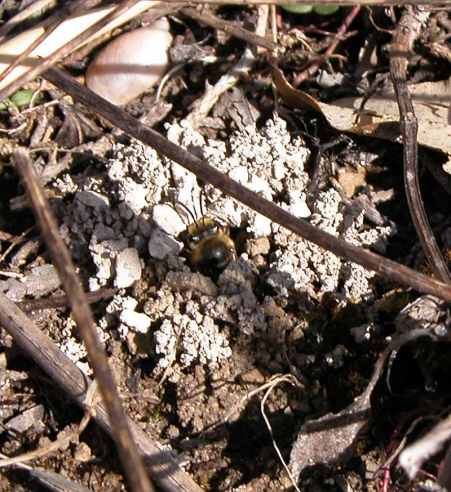
Here’s a similar species emerging from a hole in early April; the fresh earth around this hole suggests this might be a female at her recently excavated nest.
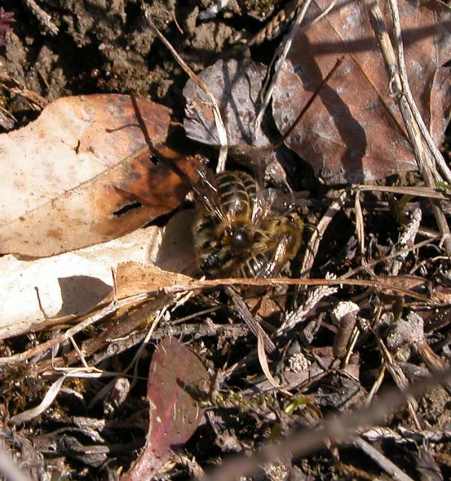
Apparently, males often emerge from their natal holes first. They then wait eagerly for the emergence of females. This is probably a mating ball – a cluster of males attempting to mate with a newly emerged female.
In this video, which I took in late April a couple of years ago, you can see a female of another species of what I’m guessing is also Andrea. She is digging her nest into a bank along Kinderhook Creek; don’t ask me why she seems to eventually dump her pollen load. Maybe an interloper (me?) buried her burrow entrance, and she hadn’t planned on having to dig with her load. Numerous others of her kind (plus a few with different intentions, see below) were flying about.
Other native bees nest in the hollows of bark-encased rotting twigs, hollow reeds or other narrow, tube-like locations. See “Strumelia’s” comments at the end of this blog, they show some good footage of the nest she set up for Mason bees on her back porch.
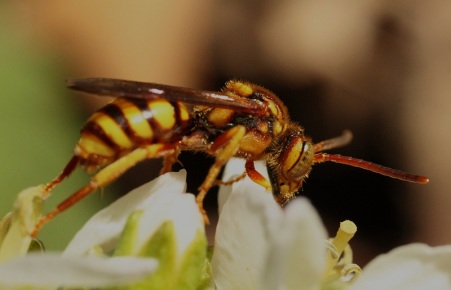
This wasp-like bee, probably Nomada imbricata, is apparently a cleptoparasite of Andrena species such as the one mentioned earlier.
All is not sweet flowers and sunshine in the world of spring bees. The species pictured above takes advantage of the pollen collection done by bees like the aforementioned Andrena. This (despite my initial error) is a bee, but note that it is lacking the hairy, pollen-holding legs of the bee in the previous picture. This species does feed pollen to its young, but yet doesn’t gather pollen from flowers. How does it manage? It searches out the well-stocked nursuries of other species and lays its eggs therein. Its larvae then develop, probably kill the young of the other species, and feast upon the pollen cache…

These little black bees are the bane of novice bee taxonomists like ourselves. Many are in the genus Lasioglossum; there are nearly 70 species of this genus in NY.
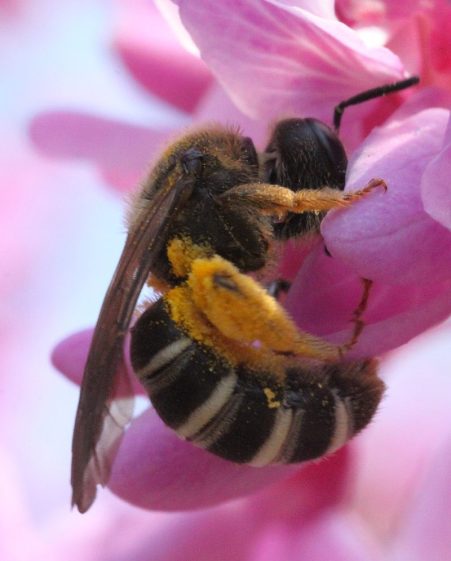
This is a bee in the genus Halictus, a genus in the same family as Lasioglossum. It’s reaching into the purse-like cup that shields the Redbud flower’s anthers and styles.
Lasioglossum and Halictus are largely ground nesters. Some are social and live in small colonies with a single queen, although, like the Bumblebee, it seems that it is the queens rather than the colonies that overwinter. As one might expect given the time needed to establish a colony, some of these species have fairly long flight periods. They fly, for example, for substantially longer than Redbud flowers. As a result, if one wants to encourage native bees in one’s garden, one often needs to ensure that a stream of different plant species is in flower across the season. This is also a reason why we should maintain a diversity of natural habitats in our landscape: the flowers of floodplains, wetlands, and dry fields, for examples, tend to bloom during different seasons and thus by maintaining a diverse landscape, one can provide a season-long source of food for long-flying native bee species.
Another aspect of supporting bees is ensuring that you have a variety of flower types. For example, one web document suggested that Redbud is primarily fertilized by “long-tongued” bees (apparently because the nectaries take a bit of dipping to reach). Another site categorized Halictus as a short-tongued bee. So, why these Halictus on Redbud? One answer might be that, despite appearing to have a short tongue in a picture like this, at least some Halictus have a much longer reach. Pictures and video viewable at Bugguide may help explain the paradox.

Some bees are specialists. This photograph, taken by Martin Holdrege, shows a cluster of Squash Bees, aka Peponapis, huddled in the center of a squash flower. These bees are squash pollinators around the world (although, like squash, their original homeland was the Americas). They are effective pollinators, often rendering Honey Bee pollination unnecessary. To see them, gently pry open squash flowers in the early morning. Needless to say, while our spring is advanced this year, Martin did not take this photo in April.
Some native bees, like the Peponapis above, are plant specialists. Their behavior and morphology is adapted to the flowering patterns and flower structures of cucurbids. There are also bees in our fauna who specialize on willows, composits, and Pickerel Weed.
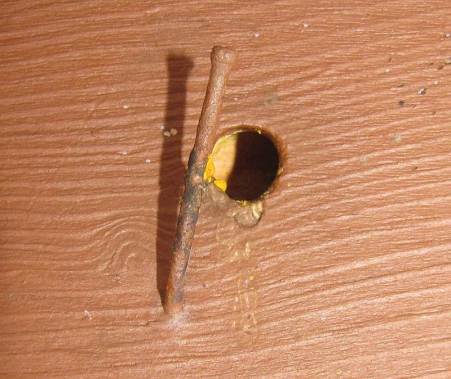
By the time I first got around to doing this blog, temperatures had dropped, and the Carpenter Bees, which had been swirling around some of our eaves, had hunkered down. Their 1/3-1/2″ diameter holes were however still evident, complete with what appear to be scrapped off pollen traces.
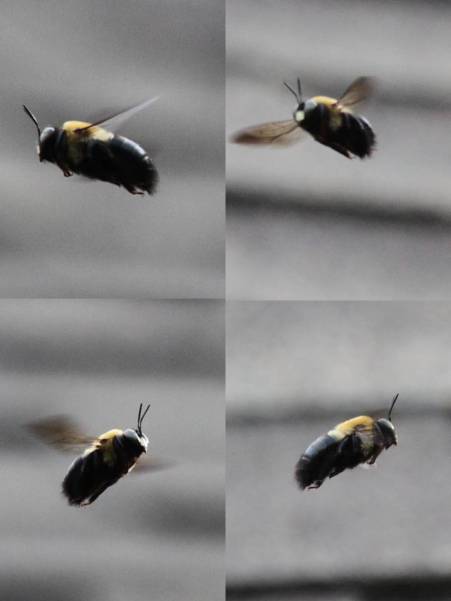
However, things eventually warmed up; this is a male Eastern Carpenter Bee photographed while patrolling his territory. He’s Bumblebee sized but note the shiny (not fuzzy), black abdomen and the white face (only on the guys).
Carpenter Bees are another group of native bees; we have one species in our area. These bees can be effective pollinators, but have had bad PR. First, they do not eat wood. Instead, like ground nesting bees, they are trying to make holes to house their young. To do so, they excavate into the wood, creating small drillings. However, the young do not feed on their house, instead, like most other bees, the mother supplies with a mix of pollen and nectar. Most Carpenter Bee damage is thus cosmetic. Second, adult Carpenter Bees are large and, aside from their largely hairless abdomens, resemble Bumblebees. Males are territorial and can be conspicuous around buildings where they occasionally zoom out to alarm passing humans. However, they have no stinger and so are harmless. Females, which could sting, are apparently much more laid back and rarely approach people.
At the beginning of this blog, I mentioned that many of the little, fly-like organisms flying around flowers are actually native bees. Some, such as the one picture above, are… flies. Flies come in a variety of shapes and sizes, but they all have only two wings (vs. the bee’s four), and they usually have round, eye-dominated faces sprouting stubby antennae. Flies can also be important pollinators; indeed, some flowers seem to raise a stink that is specifically intended to attract flies rather than bees.
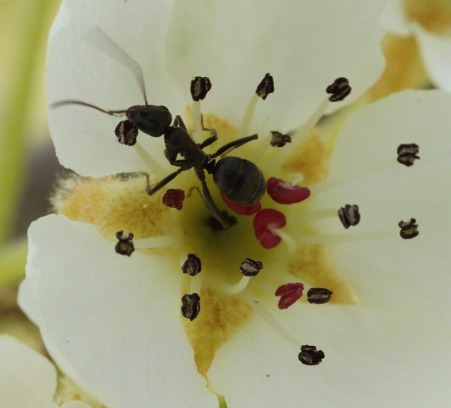
Some ants are also nectar and possibly pollen consumers; they may account for some pollination but, in most cases, are probably not particularly important in this sense.
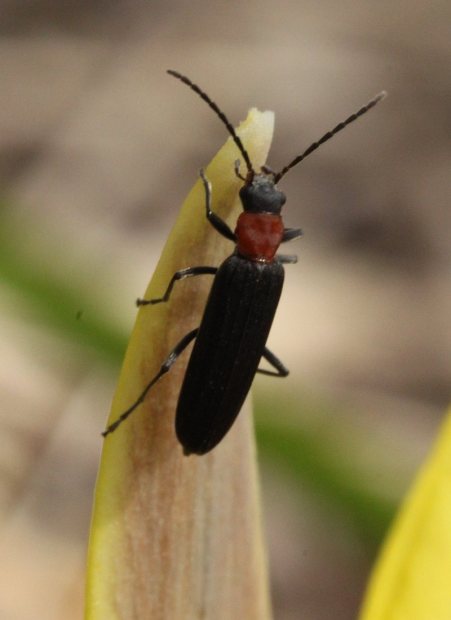
These Soldier Beetles were common in and about flowers both in our little orchard and amongst the Spring ephemerals of the floodplain. Apparently, they are both pollen feeders and predators on flower visitors.
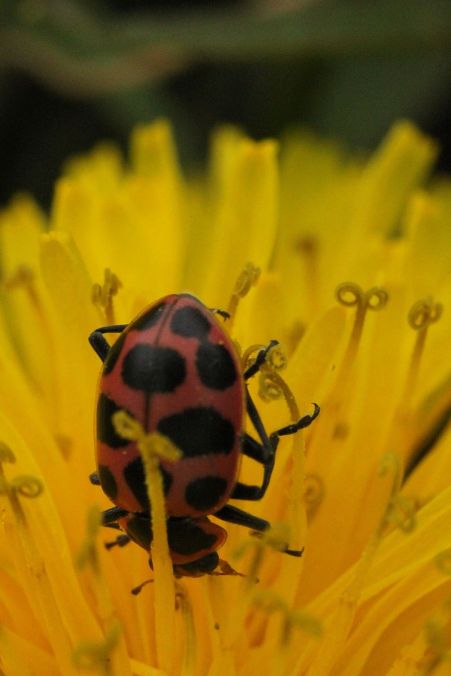
Bottoms up. Our native Spotted Lady Beetle is a pollen feeder, but both larvae and adults can be important pest predators in gardens.

Finally, even as sketchy an account of flower visitors as this one should not overlook the butterflies. We caught this medium-sized, greyish butterfly flitting through spring emphemerals in the floodplain at the bottom of Phudd Hill. It was new to me, and I initially misidentified it. However, inspection of the photos left little doubt it was a new record for the County – a White M Hairstreak.
The White M Hairstreak (see the “M” just below the orange dot?) seems to be a butterfly on the move. It has been spreading north, probably in response to climate warming. We are currently on the northern frontier of its range, but that frontier has been continuously shifting north in recent years. The White M’s caterpillars feed on oak, and thus it probably spends much of its time in the canopy; this one had probably descended to forage for nectar amongst the ground-level wild flowers. For more on this species, see Sharon Stichter’s description of the White M in Massachusetts. While there, check out all the other interesting butterfly info. at her site.

